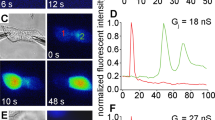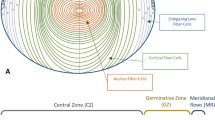Abstract
The lenses of vertebrate and cephalopod eyes differ onto-genetically and in other respects. The vertebrate lens, derived from a single cell type, consists mainly of long fibre cells continuously produced by division and elongation of columnar epithelial cells near the lens equator. Almost 50% of the fibre cell surface consists of junctional complexes1,2 and the internal resistance, from point to point within the lens, is low compared with the surface membrane resistance3. Thus the vertebrate lens is expected to behave as a well coupled syncytial system4. The cephalopod lens, however, is formed by the fusion of two distinct cell types5; the anterior segment has the same ontogenetic origin as the cornea but the posterior segment shares a common origin with the retina, and the plane of contact of the two cell types can be seen in light-microscope sections5. Most of the lens is composed of long fibre cells similar in appearance to those found in the vertebrate lens, and membrane junctional regions between adjacent fibres have also been tentatively identified6. We now describe electrophysiological investigations of cellular communication in the cephalopod lens, which show marked differences in the intercellular electrical coupling within the vertebrate (amphibian) and cephalopod lens.
This is a preview of subscription content, access via your institution
Access options
Subscribe to this journal
Receive 51 print issues and online access
$199.00 per year
only $3.90 per issue
Buy this article
- Purchase on Springer Link
- Instant access to full article PDF
Prices may be subject to local taxes which are calculated during checkout
Similar content being viewed by others
References
Philipson, B. T., Hanninen, L. & Balazs, E. A. Expl Eye Res. 21, 205–219 (1975).
Kuszak, J., Maisel, H. & Harding, C. V. Expl Eye Res. 27, 495–498 (1978).
Duncan, G. Expl Eye Res. 8, 406–414 (1969).
Duncan, G. in The Eye Vol. 5 (eds Davson, H. & Graham, L. T.) 357–398 (Academic, London 1974).
Duke-Elder, S. System of Ophthalmology Vol. 1 (Kimpton, London, 1958).
Delamere, N. A. & Duncan, G. J. Physiol., Lond. 272, 167–186 (1977).
Clayton, R. M. in The Eye Vol. 5 (eds Davson, H. & Graham, L. T.) 399–494 (Academic, London, 1974).
Dohrn, A. Expl Eye Res. 9, 297–299 (1970).
Jacob, T. J. C. & Duncan, G. Expl Eye Res. 31, 505–512 (1980).
Duncan, G., Patmore, L. & Pynsent, P. B. J. Physiol., Lond. 312 (in the press).
Author information
Authors and Affiliations
Rights and permissions
About this article
Cite this article
Jacob, T., Duncan, G. Electrical coupling between fibre cells in amphibian and cephalopod lenses. Nature 290, 704–706 (1981). https://doi.org/10.1038/290704a0
Received:
Accepted:
Issue Date:
DOI: https://doi.org/10.1038/290704a0
This article is cited by
-
A comparative study of the membrane permeability properties of amphibian and cephalopod mollusc lenses
Journal of Comparative Physiology B (1984)
-
Fine structure of the ocellus of Sarsia tubulosa (Hydrozoa, Anthomedusae)
Zoomorphology (1982)
Comments
By submitting a comment you agree to abide by our Terms and Community Guidelines. If you find something abusive or that does not comply with our terms or guidelines please flag it as inappropriate.



